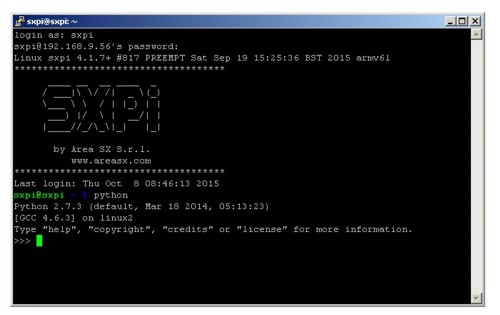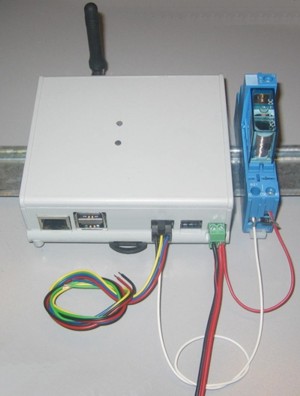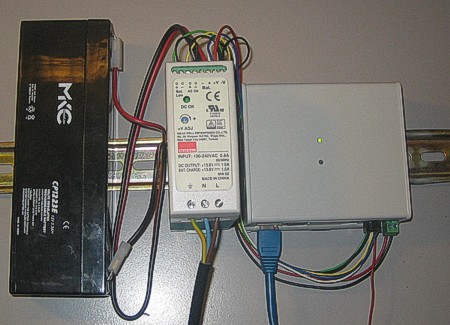SXPi: a compact hardware, powerful, inexpensive, with all the simplicity and flexibility of Linux OS.
Inputs, outputs, 3G UMTS modem, serial interface; all that is needed for small and large projects.

Description
In a compact plastic case only 97mm x 105mm (6 modules), suitable for DIN rail, the SXPi encloses a 700Mhz or 900MHz powerful processor
with 512MB or 1GB RAM (respectively Raspberry PI or Raspberry PI 2)) and Telit modem HE910 GSM / UMTS.
Besides this powerful core there are: an Ethernet 10/100Mbps interface, two USB 2.0 type A, an RS485 port, an RS232 port, two open collector outputs,
two photo-coupler inputs and two signal LEDs (one bi-color) driven by software.


Internally connected via USB directly to the ARM11 core, on the SXPi there is one of the best performing modem by Telit which is the HE910-EUD.
The latter is a 3.5G generation modem compliant with standard GSM/GPRS (850/900/1800/1900MHz) and UMTS/HSPA (850/900/2100MHz)
and with a connection speed up to 14.4 Mbit/s in download, of course where the chosen Mobile Operator and network allows it.
On customer request, the SXPi can be assembled with the HE910-EUG modem, with same features but with a very sensitive (-165 dBm)
28 channels A-GPS, which makes SXPi the ideal hardware solution for developing automotive and tracking systems.
The powerful processor 700Mhz core, based on Raspberry PI or PI 2, allows you to run a complete Raspbian Linux distribution
hosted on a microSD 8Gb (provided).
Just as you can on a ordinary PC, you can install server applications on SXPi such as the Apache web server complete with PHP interpreter
and the MySQL database.
The Linux Box SXPi can be programmed using virtually all the known languages in the Open Source range such as, for example:
C, C ++, Python, Java, PHP, Perl, Shell.
Main technical features
The following ones are the main technical features of SXPi:
- SXPI ((prodotto non trovato)): Processor ARM11 700Mhz with 512Mb SDRAM (Raspberry Pi Model B+)
SXPI2 ((prodotto non trovato)): Processor Cortex-A7 900Mhz with 1Gb SDRAM (Raspberry Pi 2 Model B)
- Operating System on SD card
- Modem Telit HE910-EUD GSM: 850/900/1800/1900MHz, UMTS/HSPA+: 850/900/2100MHz
- Ethernet interface with RJ45 10/100Mbps
- 2 USB interfaces 2.0 TYPE A
- 2 RS232 interfaces
- RS485 interface on terminal block
- 2 digital inputs photo-coupler (Vin max 24V CC)
- 2 open collector output (max current 500mA)
- 1 Audio and Video composite output on jack 3.5mm
- 1 HDMI full HD output
- Wide range power supply from 9V up to 24V AC/CC
- Antenna GSM/UMTS and GPS (optional) with SMA connector
- Bicolor Led driven by software
- Size: 97x105x38mm
- Weight: 170g
- Protection class: IP40
- Operating Temperature: 0°C +70°C
- Operating Humidity: 5% - 85%
Software
As previously said, the SXPi integrates the well know Raspberry PI board;
This feature, besides making the system reliable and powerful, has the advantage of allowing access to an endless amount
of documentation and examples on the internet, allowing virtually anyone to begin to develop systems and products on their own.
The SXPi is supplied with an SD card 8Gb (already inserted into the product socket) with pre-installed Raspbian distribution,
customized to work with all devices on board.
To begin working with the SXPi, just supply power to the board with a voltage between 9V and 24V and wait for the Linux system boot.
The access to the console is possible via the serial port on the RJ11 connector by setting a communication speed of 115200bps
or via Ethernet network by SSH connection.

The Linux distribution is provided by default with the LAN configured in DHCP
username: sxpi password: sxpi

Hardware
The SXPi is equipped with two connectors MicroFit with 6 poles.
On these connectors there are: two open collector outputs (max current 500mA) for controlling, for example,
two relays; two photo-coupler inputs and one RS232 port.
Below you find the pinout of the two MicroFit P9 and P10:

Microfit P9
| Pin | Name | I/O | Description |
| 1 | IN2 OPTO + | I | Photo-coupler input pin + |
| 2 | IN2 OPTO - | I | Photo-coupler input pin - |
| 3 | +5V Vcc | O | Voltage +5V max 250mA |
| 4 | IN1 OPTO + | O | Photo-coupler input pin + |
| 5 | IN1 OPTO - | I | Photo-coupler input pin - |
| 6 | GND | O | Ground GND |
Microfit P10
| Pin | Name | I/O | Description |
| 1 | GND | O | Ground GND |
| 2 | OC2 | O | Open collector 1 (max 500mA) |
| 3 | OC1 | O | Open collector 2 (max 500mA) |
| 4 | RX RS232 | I | Input RX RS232 |
| 5 | TX RS232 | O | Output TX RS232 |
| 6 | GND | O | Ground GND |
The following picture shows the schematics to drive a relay (Power Relay for DIN rail) with the SXPi.


Power supply with battery backup
To let the SXPi work properly also in case of power failure, you can use a power pack
with UPS function and DIN rail mounting such as DRC-40 by Meanwell.

This power pack, starting from an input voltage ranging between 90VAC and 264VAC,
is able to charge and maintain a 12V lead battery and, at the same time, provide a stable DC voltage to power on the SXPi.
The power pack UPS DRC-40 has two open collector outputs for pointing out the failure of main power supply and the battery low level (Vbat <11V).
In the following picture, the schematics of the connection between the UPS power pack by MEAN WEL and the SXPi:

By realizing this circuit, it is possible to control via software the status of the main power supply (pin 21 Raspberry pi)
and the battery level (pin 19 Raspberry pi).
Extensions and custom software development
The board SXPi can be extended simply by using the USB ports or the RS485 line. Some useful possibilities are for example:
- An USB/WiFi interface to get a wireless connection
- An EXP485 I/O board(EXP485 Scheda di espansione I/O Modbus su RS485) to extend the number of inputs and outputs
- A pen drive USB to realize logging system or tracking with removable log

The possibilities are virtually endless since every USB device, with Linux drivers, can be theoretically used on the system.
As usual, Area SX staff is ready to evaluate the feasibility of the project you need and to develop custom software on demand.
Related items
Programmare in Python la SXPi
Trasformare la SXPi in un mini server LAMP
How to enable the 3G and Wi-Fi connectivity on the SXPi
An OpenVPN encrypted connection using the SXPi
Riprodurre un file MP3 con la SXPi
Documentation
 Telit_HE910_UE910_AT_Commands_Reference_Guide_r5.pdf Telit_HE910_UE910_AT_Commands_Reference_Guide_r5.pdf
 Manuale_SXPi.pdf Manuale_SXPi.pdf
 Manual_SXPi_eng.pdf Manual_SXPi_eng.pdf
Segnala questo articolo:
Tags: - ARM9 - Domotica - GPRS - GSM - Linux - RS485 - Schede Area SX - SMS - USB -
|

 Articles
Articles  Mini PC
Mini PC  Mini PC
Mini PC  SXPi not just a Linux Box
SXPi not just a Linux Box



 Area SX store
Area SX store

























 Read more info on this product
Read more info on this product











